SAIC Motor Corporation Bundle
Can SAIC Motor Corporation Navigate the EV Revolution?
The automotive industry is in the midst of a seismic shift, with electric vehicles (EVs) and evolving consumer demands reshaping the landscape. SAIC Motor Corporation, a major player in this transformation, faces both immense opportunities and significant challenges. This article provides a deep dive into the SAIC Motor Corporation SWOT Analysis, exploring its position in this dynamic market.
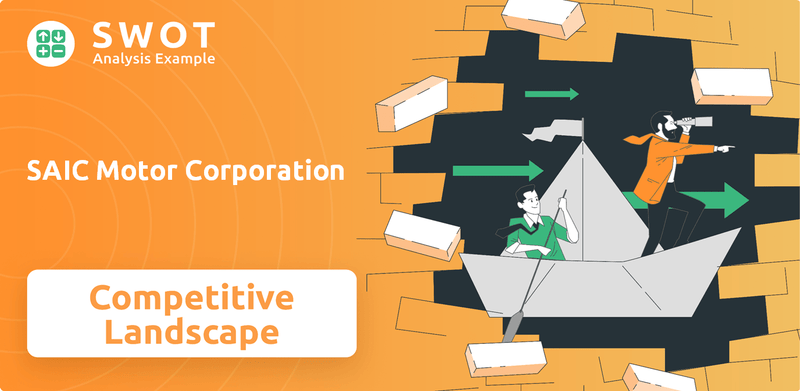
This analysis will dissect SAIC Motor's competitive landscape, examining its market share, key rivals, and strategic responses to industry trends. We'll explore the company's competitive advantages and dissect the challenges it faces in the rapidly evolving automotive industry. Understanding SAIC Motor's position is crucial for investors, analysts, and anyone seeking to understand the future of the global automotive market, including its electric vehicle strategy and regional market analysis.
Where Does SAIC Motor Corporation’ Stand in the Current Market?
SAIC Motor Corporation's market position has seen shifts, particularly in China's automotive industry. The company, a major player in the global automotive market, has a diverse product portfolio and a significant presence in both domestic and international markets. This analysis examines the competitive landscape, market share, and strategic moves of SAIC Motor, including its financial performance and future outlook.
SAIC Motor's competitive advantages include its joint ventures with global automotive leaders and its expanding electric vehicle (EV) offerings. However, it faces challenges from competitors and market dynamics. This report provides a detailed SAIC Motor analysis, focusing on its market position, competitive strategies, and industry trends.
SAIC Motor reported 2024 terminal deliveries of 4.639 million vehicles. While it achieved a record high in new energy vehicle (NEV) sales, reaching 1.234 million units (a 9.9% year-on-year increase), BYD surpassed it as China's top-selling automaker in 2024. SAIC's wholesale sales for 2024 amounted to 4.013 million units.
SAIC Motor's product lines include its own brands like MG, Roewe, and Maxus, and joint ventures with Volkswagen and General Motors. In 2024, sales from its self-owned brands reached 2.408 million units, accounting for 60% of total sales. This represents a 5 percentage point increase from 2023.
SAIC's NEV sales surged to a record 1.234 million units in 2024, up 9.9% year-on-year. Its premium NEV brand, IM Motors, saw sales increase by 71.2% to 66,000 units in 2024. This growth is a key part of its electric vehicle strategy.
SAIC Motor has a robust global presence, with products and services in over 100 countries across six continents. By the end of 2024, overseas vehicle deliveries exceeded 5.5 million units, making it the leading Chinese automaker in export volume for eight consecutive years.
Despite strong sales, SAIC's financial health faced challenges. Its preliminary profit for 2024 was projected to drop significantly. However, SAIC Motor still reported a 12% year-on-year rise in net profit to 23.5 billion yuan for 2025. Total revenue in 2024 was 744.705 billion RMB.
SAIC Motor faces intense competition in the automotive industry, particularly in the NEV segment. The company's market position is influenced by its ability to adapt to changing consumer preferences and technological advancements. The competitive landscape includes both domestic and international automakers, requiring SAIC Motor to continually innovate and refine its strategies.
- BYD's rise as China's top-selling automaker.
- Intense price competition in the automotive market.
- Impact of the writedown of its joint venture with General Motors.
- Focus on expanding overseas sales and market share.
For more insights into SAIC Motor's strategic initiatives, including its growth strategy, consider reading the article: Growth Strategy of SAIC Motor Corporation.
SAIC Motor Corporation SWOT Analysis
- Complete SWOT Breakdown
- Fully Customizable
- Editable in Excel & Word
- Professional Formatting
- Investor-Ready Format
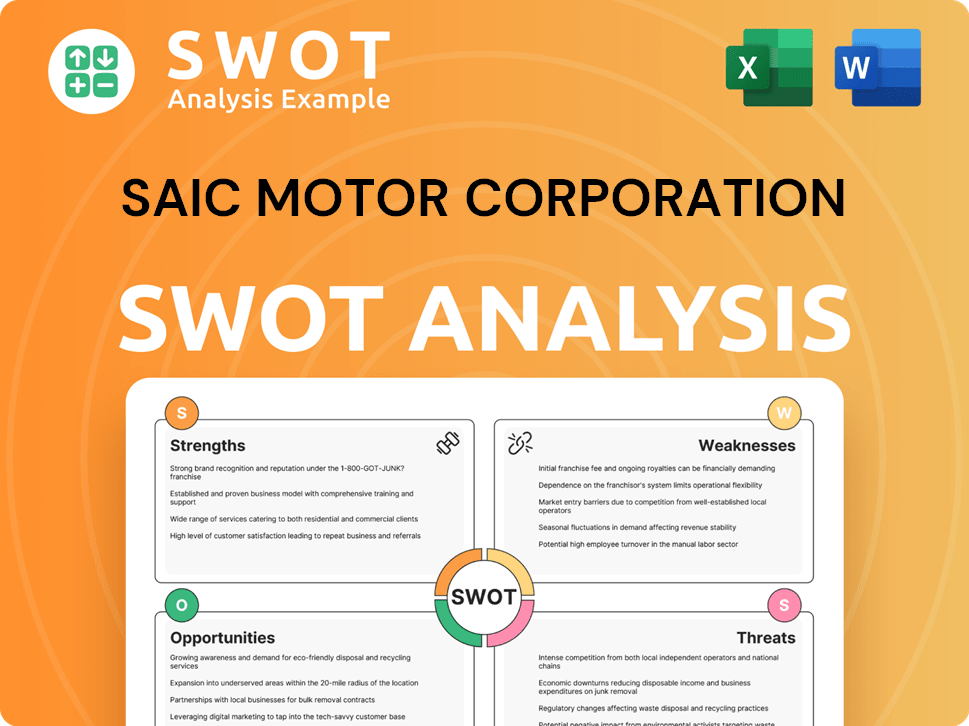
Who Are the Main Competitors Challenging SAIC Motor Corporation?
The SAIC Motor Corporation operates within a highly competitive environment, facing challenges from both established domestic and emerging players. The automotive industry is undergoing significant transformation, particularly in the new energy vehicle (NEV) sector, intensifying the need for SAIC Motor analysis to understand its market position and competitive advantages. Understanding the competitive landscape is crucial for evaluating SAIC Motor's future outlook and developing effective competitive strategies.
SAIC Motor's key rivals include both direct competitors in the Chinese market and new entrants from the technology sector. The company's market share is constantly under pressure as competitors introduce innovative products and strategies. SAIC Motor's electric vehicle strategy is critical for maintaining its position, given the rapid growth of the EV market and the need to address market challenges.
BYD, Geely, and Great Wall Motor are significant direct competitors challenging SAIC Motor in the Chinese market. BYD has emerged as a formidable rival, surpassing SAIC as China's top-selling automaker in 2024 with 4.27 million vehicle sales. These companies are also introducing smart models, intensifying competition.
Newer entrants and technology companies are disrupting the traditional competitive landscape. Xiaomi's SU7 sedan is an example of a tech-savvy competitor. Startups like Xpeng are also challenging established players with their smart models. SAIC's own electric vehicle brands, IM Motors and Rising Auto, have struggled to gain traction.
SAIC's joint ventures with Volkswagen and General Motors are losing ground to Chinese carmakers. Despite this, the SAIC-Volkswagen joint venture's Volkswagen ID. series was the best-selling EV among joint ventures in China in 2024, selling over 130,000 vehicles, a 23.8% increase year-on-year. SAIC-Volkswagen also sold over 1.2 million vehicles in 2024.
BYD's aggressive surge in battery electric vehicle (BEV) sales, with a 764% increase in 2025, highlights its strong position in the EV market. This growth underscores the intense competition SAIC Motor faces in the electric vehicle segment.
In November 2024, the Rising Auto brand was reintegrated into Roewe, ending its status as an independent brand and being restructured as a premium electric vehicle product line under Roewe. This strategic move reflects the challenges SAIC Motor faces in establishing its own EV brands.
SAIC formed a collaboration with Audi in May 2024 to develop high-end intelligent electric vehicles and a smart digital platform. This partnership aims to strengthen SAIC's position in the premium EV market.
SAIC Motor's key rivals include a mix of established domestic automakers and new entrants. The competitive landscape is dynamic, with the EV sector experiencing rapid growth and innovation. Understanding the strategies of these competitors is crucial for SAIC Motor's success.
- BYD: A leading EV manufacturer that has surpassed SAIC in sales.
- Geely: A major domestic automaker expanding its smart model offerings.
- Great Wall Motor: Another significant Chinese automaker intensifying competition.
- Xiaomi: A technology company entering the automotive market with the SU7 sedan.
- Xpeng: An EV startup challenging established players with smart models.
SAIC Motor Corporation PESTLE Analysis
- Covers All 6 PESTLE Categories
- No Research Needed – Save Hours of Work
- Built by Experts, Trusted by Consultants
- Instant Download, Ready to Use
- 100% Editable, Fully Customizable
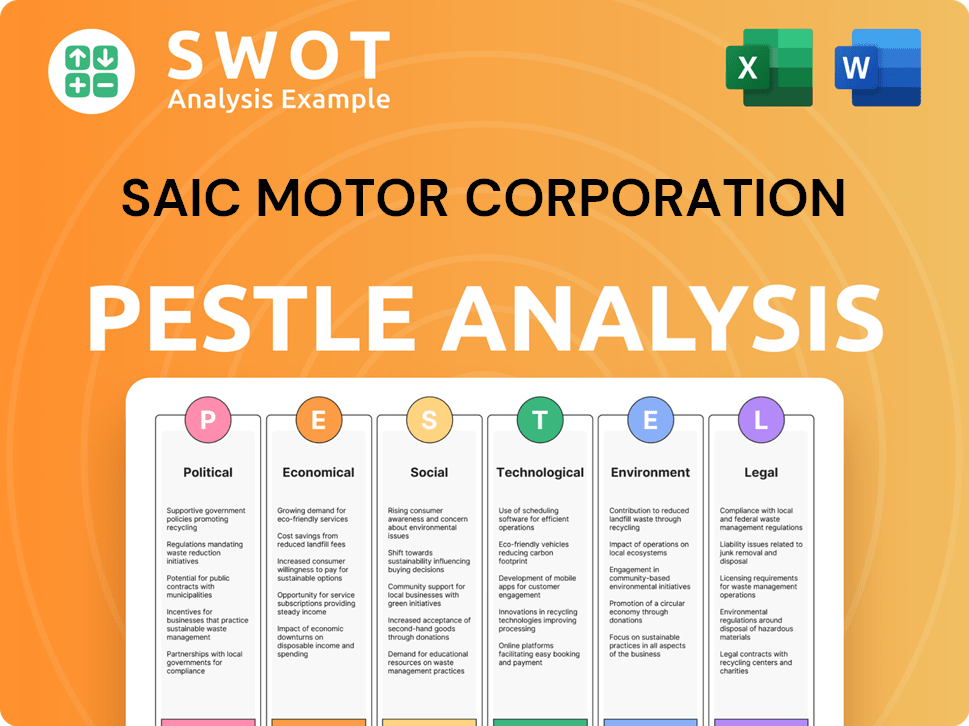
What Gives SAIC Motor Corporation a Competitive Edge Over Its Rivals?
The competitive landscape of SAIC Motor Corporation is shaped by its extensive operational scale, strategic partnerships, and a growing emphasis on technological innovation. SAIC Motor's analysis reveals a company leveraging its comprehensive value chain and global presence to maintain a strong market position. The automotive industry is highly competitive, and SAIC Motor's ability to adapt and innovate is crucial for its continued success.
SAIC Motor's key rivals include both domestic and international automakers, each vying for market share in a rapidly evolving industry. The company's strategic moves, such as its focus on new energy vehicles (NEVs) and collaborations with technology partners, are designed to strengthen its competitive advantages. Understanding SAIC Motor's market position requires a deep dive into its financial performance, product portfolio, and electric vehicle strategy.
SAIC Motor's competitive advantages are multifaceted, encompassing its operational scale, strategic alliances, and technological advancements. SAIC Motor Corporation's competitive advantages are critical for its success in the automotive industry. The company's ability to navigate market challenges and capitalize on industry trends will determine its future outlook.
SAIC Motor's scale is a significant advantage, ranking among the top companies globally. Its end-to-end presence in the auto market, from manufacturing to international operations, provides a comprehensive value chain. The company's self-owned vehicle logistics fleet has expanded to 35 vessels, including the 'ANJI ANSHENG', enhancing its export capabilities.
SAIC Motor's joint ventures with Volkswagen and General Motors have historically provided access to established markets and advanced technologies. The renewal of the joint venture with Volkswagen until 2040 and the collaboration with Audi for high-end EVs highlight the importance of these partnerships. SAIC is also working with Huawei for its new EV brand, Shangjie, launching in late 2025.
SAIC has invested heavily in R&D, with nearly 150 billion yuan ($20.52 billion) invested in core smart and electric vehicle technologies over the past decade. The company launched the 'Seven Technological Pillars 2.0,' including solid-state batteries and advanced intelligent driving. Semi-solid-state batteries are set for mass production in 2024, and SAIC aims to deploy cutting-edge technologies in 2025.
The MG brand, acquired in 2007, has become a global success, selling over 5 million vehicles worldwide. The MG4 EV, launched in 2022, has been a key factor in this expansion. MG ranks among the top ten best-selling brands in over 20 countries, demonstrating SAIC's ability to transform and grow its brands internationally.
SAIC Motor's competitive advantages are rooted in its robust operational scale, strategic partnerships, and technological prowess. The company's focus on NEVs and its global presence position it well for future growth. Understanding SAIC Motor's competitive advantages is essential for evaluating its market position.
- Extensive value chain and global reach.
- Strategic alliances with major automakers and tech companies.
- Significant investment in R&D and technological innovation.
- Successful global brand expansion with the MG brand.
SAIC Motor Corporation Business Model Canvas
- Complete 9-Block Business Model Canvas
- Effortlessly Communicate Your Business Strategy
- Investor-Ready BMC Format
- 100% Editable and Customizable
- Clear and Structured Layout
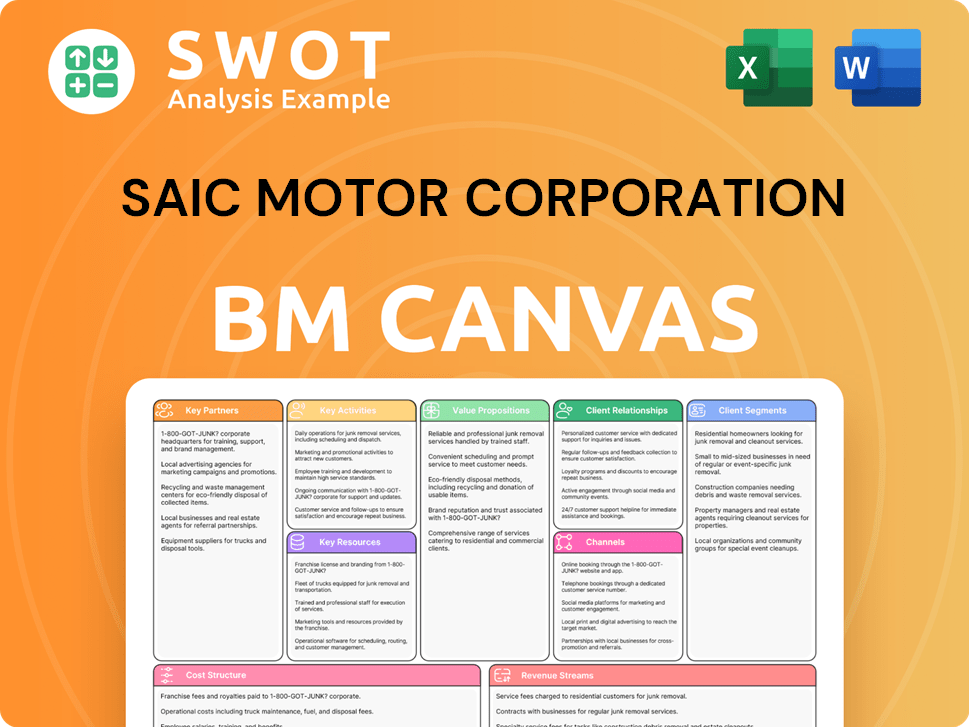
What Industry Trends Are Reshaping SAIC Motor Corporation’s Competitive Landscape?
The global automotive industry is undergoing a significant transformation, driven by the rapid adoption of electric vehicles (EVs), technological advancements, and evolving consumer preferences. This dynamic environment presents both challenges and opportunities for established players like SAIC Motor Corporation. Understanding the SAIC Motor analysis within this context is crucial for assessing its market share and future prospects.
SAIC Motor Corporation's position in the competitive landscape is influenced by its strategic initiatives in electrification, technological innovation, and global expansion. However, the company faces risks from intense market competition, economic uncertainties, and the need to adapt quickly to technological changes. The future outlook for SAIC Motor Corporation depends on its ability to navigate these challenges and capitalize on emerging opportunities in the evolving automotive industry.
A key trend is the accelerating shift towards New Energy Vehicles (NEVs), especially EVs and HEVs. China aims for 50% NEV penetration by 2025. SAIC is focusing on electrification, with NEVs accounting for 34% of monthly sales in April 2025, up from 18% in early 2024. SAIC Motor analysis reveals that it plans to sell 3.5 million NEVs by 2025.
Intense price wars in the Chinese market impact profitability. SAIC's preliminary profit for 2024 showed a significant drop, with substantial impairment provisions in 2025. The NEV sector's volatility, including overcapacity and technological obsolescence, poses challenges. Addressing dependence on traditional vehicle sales is crucial.
Leveraging favorable government policies for domestic EVs is a key opportunity. Capitalizing on expertise in technical hardware and integrated ecological platforms is also important. Strategic divestment of underperforming assets to reallocate capital to high-potential areas like autonomous driving and software-defined vehicles. The company's collaborations are key for growth.
SAIC is investing 300 billion yuan by 2025 to become a technology company focused on smart and electric vehicles. The 'Glocal Strategy,' introduced in April 2025, emphasizes global reach with local adaptation, introducing 17 new models for international markets. SAIC's strong overseas performance, with over 1 million vehicles sold abroad annually for the past three years, is a key strength. For more insights, check out the Target Market of SAIC Motor Corporation.
SAIC Motor Corporation is adapting to the evolving automotive industry by focusing on NEVs, technological advancements, and global expansion. The company is facing challenges such as intense market competition and economic uncertainties. However, it has opportunities to leverage favorable government policies and its expertise in technology.
- The company is investing heavily in smart and electric vehicles.
- It is expanding its global presence with its 'Glocal Strategy'.
- SAIC aims to sell 3.5 million NEVs by 2025.
- The company's ability to navigate these challenges will determine its future success.
SAIC Motor Corporation Porter's Five Forces Analysis
- Covers All 5 Competitive Forces in Detail
- Structured for Consultants, Students, and Founders
- 100% Editable in Microsoft Word & Excel
- Instant Digital Download – Use Immediately
- Compatible with Mac & PC – Fully Unlocked
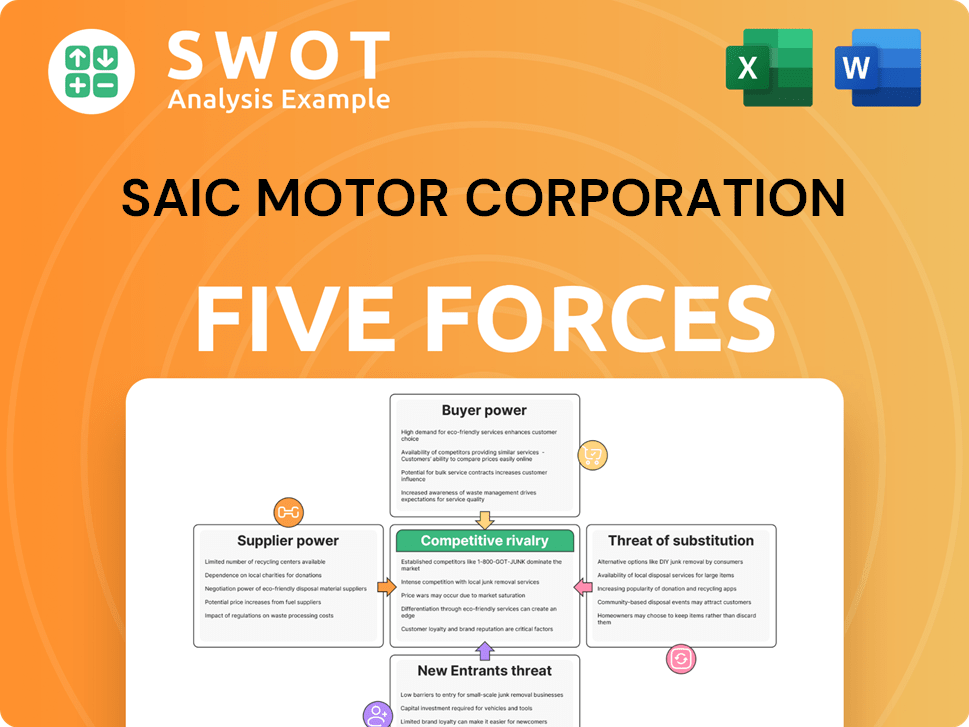
Related Blogs
- What are Mission Vision & Core Values of SAIC Motor Corporation Company?
- What is Growth Strategy and Future Prospects of SAIC Motor Corporation Company?
- How Does SAIC Motor Corporation Company Work?
- What is Sales and Marketing Strategy of SAIC Motor Corporation Company?
- What is Brief History of SAIC Motor Corporation Company?
- Who Owns SAIC Motor Corporation Company?
- What is Customer Demographics and Target Market of SAIC Motor Corporation Company?
Disclaimer
All information, articles, and product details provided on this website are for general informational and educational purposes only. We do not claim any ownership over, nor do we intend to infringe upon, any trademarks, copyrights, logos, brand names, or other intellectual property mentioned or depicted on this site. Such intellectual property remains the property of its respective owners, and any references here are made solely for identification or informational purposes, without implying any affiliation, endorsement, or partnership.
We make no representations or warranties, express or implied, regarding the accuracy, completeness, or suitability of any content or products presented. Nothing on this website should be construed as legal, tax, investment, financial, medical, or other professional advice. In addition, no part of this site—including articles or product references—constitutes a solicitation, recommendation, endorsement, advertisement, or offer to buy or sell any securities, franchises, or other financial instruments, particularly in jurisdictions where such activity would be unlawful.
All content is of a general nature and may not address the specific circumstances of any individual or entity. It is not a substitute for professional advice or services. Any actions you take based on the information provided here are strictly at your own risk. You accept full responsibility for any decisions or outcomes arising from your use of this website and agree to release us from any liability in connection with your use of, or reliance upon, the content or products found herein.